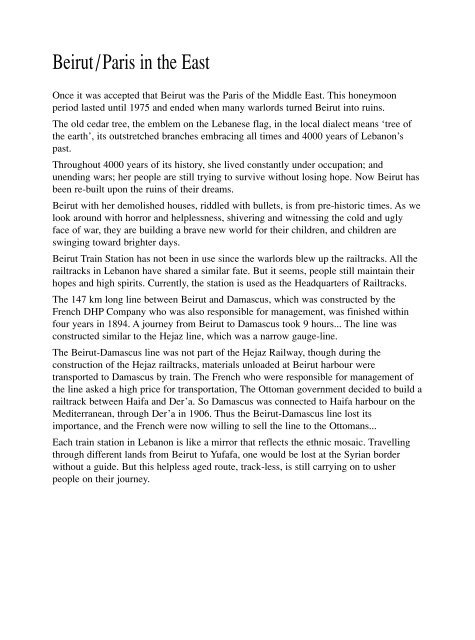Create successful ePaper yourself
Turn your PDF publications into a flip-book with our unique Google optimized e-Paper software.
Beirut / Paris in the East<br />
Once it was accepted that Beirut was the Paris of the Middle East. This honeymoon<br />
period lasted until 1975 and ended when many warlords turned Beirut into ruins.<br />
The old cedar tree, the emblem on the Lebanese flag, in the local dialect means ‘tree of<br />
the earth’, its outstretched branches embracing all times and 4000 years of Lebanon’s<br />
past.<br />
Throughout 4000 years of its history, she lived constantly under occupation; and<br />
unending wars; her people are still trying to survive without losing hope. Now Beirut has<br />
been re-built upon the ruins of their dreams.<br />
Beirut with her demolished houses, riddled with bullets, is from pre-historic times. As we<br />
look around with horror and helplessness, shivering and witnessing the cold and ugly<br />
face of war, they are building a brave new world for their children, and children are<br />
swinging toward brighter days.<br />
Beirut Train Station has not been in use since the warlords blew up the railtracks. All the<br />
railtracks in Lebanon have shared a similar fate. But it seems, people still maintain their<br />
hopes and high spirits. Currently, the station is used as the Headquarters of Railtracks.<br />
The 147 km long line between Beirut and Damascus, which was constructed by the<br />
French DHP Company who was also responsible for management, was finished within<br />
four years in 1894. A journey from Beirut to Damascus took 9 hours... The line was<br />
constructed similar to the Hejaz line, which was a narrow gauge-line.<br />
The Beirut-Damascus line was not part of the Hejaz Railway, though during the<br />
construction of the Hejaz railtracks, materials unloaded at Beirut harbour were<br />
transported to Damascus by train. The French who were responsible for management of<br />
the line asked a high price for transportation, The Ottoman government decided to build a<br />
railtrack between Haifa and Der’a. So Damascus was connected to Haifa harbour on the<br />
Mediterranean, through Der’a in 1906. Thus the Beirut-Damascus line lost its<br />
importance, and the French were now willing to sell the line to the Ottomans...<br />
Each train station in Lebanon is like a mirror that reflects the ethnic mosaic. Travelling<br />
through different lands from Beirut to Yufafa, one would be lost at the Syrian border<br />
without a guide. But this helpless aged route, track-less, is still carrying on to usher<br />
people on their journey.



